Testing steel vs lead shot on pigeon
British shooting has been divided in recent months by the announcement on the withdrawal of lead shot within five years.…
Win CENS ProFlex DX5 earplugs worth £1,149 – enter here
Moving from lead shot to steel - the practicalities involved
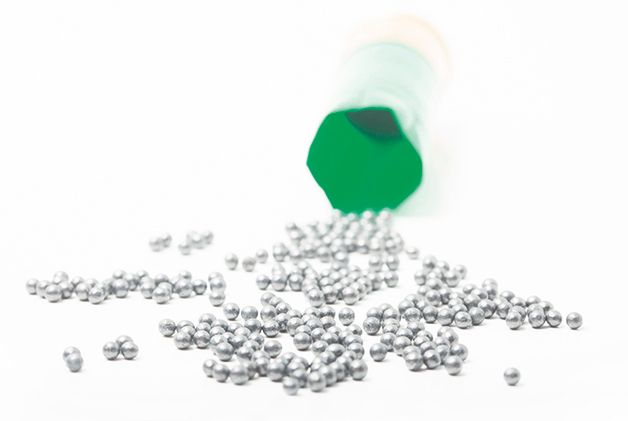 2B2H7A4 A fired/empty 12-bore, or gauge, plastic shotgun cartridge with lead shot on a white background. There are moves in the UK to switch to alternative me
2B2H7A4 A fired/empty 12-bore, or gauge, plastic shotgun cartridge with lead shot on a white background. There are moves in the UK to switch to alternative me
On 24 February, nine groups which represent shooting interests in the UK, including BASC and the GWCT, put out a joint statement that said they wanted to end the use of lead and single-use plastics (wads) in shotgun ammunition for live quarry shooting within five years. The main drive for moving from lead shot is in consideration of wildlife, the environment and to ensure a sustainable market for the healthiest game products. But is it possible?
A joint press release four days later from the pre-eminent cartridge manufacturers – Gamebore, Hull, Eley and Lyalvale Express – said that they’d had no consultation about this announcement and that it would be impossible to do what was suggested within five years without significant support.
The current cartridge options are lead with fibre wad, steel with plastic wad or expensive non-lead alternative shot with fibre wad. Development of non-lead and non-plastics are only in the early stages of development.
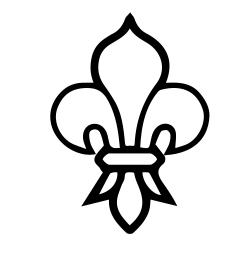
The fleur-de-lys marks your gun as safe for steel
You may be going to a game shoot that only allows non-lead shot. How do you know if you can shoot it through your gun? If you have a 12-bore, you can shoot standard steel shot cartridges through it if it is chambered 70mm (2¾in) or more, you are using less than ½ choke, it has a nitro proof mark and shot size smaller than No 4 — that is to say, No 5 and No 6. High-performance steel cartridges are also available, but your barrels must be marked with a fleur-de-lys proof mark or “steel shot” to be able to shoot them. Be aware that a lot of barrels will have the word “steel” on them but this can relate to what the barrels are made of, not what cartridges it can shoot.
All high-performance steel cartridges and boxes must be marked “high performance”. If in doubt, seek the advice of a gunsmith.
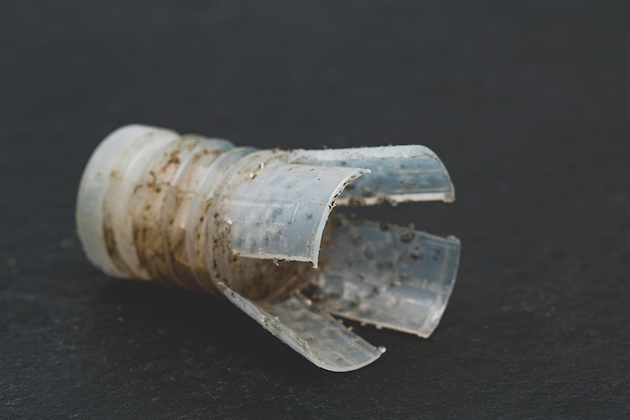
Alternatives to plastic wads are in development
If your gun is 65mm (2½in) chambered there are fewer options, most of which are expensive. This is because they are using bismuth or tungsten matrix. The smaller cartridge, like the smaller calibres, has a restriction on space within the cartridge. Steel being lighter takes up more room; this coupled with the inclusion of a full cup wad protection for the barrel means less room for shot. Smaller loads may make it possible, but this is why the cartridge companies need the time to develop a suitable solution for moving from lead shot.
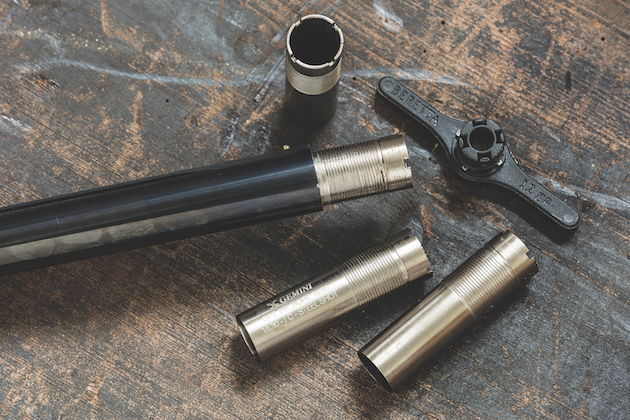
It is recommended not to use a choke tighter than modified 1/2 with steel
Steel shot is much harder than lead, but lighter. Steel needs higher pressure to get the lighter pellets as far as heavier lead ones. Tight chokes will increase the pressure in the barrel, possibly beyond its proof. This can damage the barrels. As the more uniform round steel pellets fly perfectly straight, steel shot patterns tighter than lead. It is recommended not to use a choke tighter than modified/½. This will give a pattern to the equivalent to full choke with lead shot. So, if you use improved cylinder/¼ and modified/½ with lead for game, surely cylinder and improved cylinder/¼ would be suitable for shooting game with steel? If you have a modern multichoke gun you will find ratings for lead and steel on the multichoke, that is to say lead ½, steel full or lead full, not steel. If you have a fixed-choke gun and it has a choke tighter than modified/½, you can’t use steel, even if it has steel proof marks. Speak to a gunsmith about having the choke taken out to something suitable for steel shot.
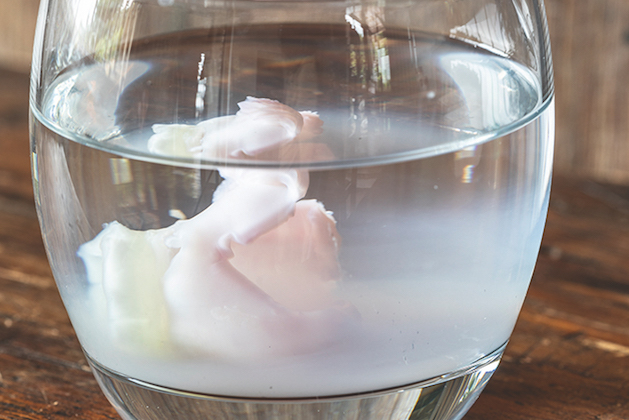
Eco-wads dissolve within 24 hours in water
Steel shot is hard and it has to be cupped to protect the barrel as it is fired. A full cup wad can be easily made out of plastic and protects the barrel well. If we are moving away from single-use plastics, what are the alternatives? Gamebore has made a full fibre cup wad since around 2002. It is expensive to produce but with more development this could become mainstream in the future. Eley has also been developing an eco-wad that degrades in a short time. There has been a notable advancement in fibre wads over the past few years.
British shooting has been divided in recent months by the announcement on the withdrawal of lead shot within five years.…
Lead has been used for shot and bullets for centuries; not because it is ideal in all applications but because…
When moving from lead shot it is recommended to use a shot size two sizes bigger than the lead equivalent. This helps to deliver more energy from the steel when connecting with the target. Steel is less dense than lead, each pellet weighing a third less. Steel cartridges with the same weight and shot size contain more pellets, giving denser patterns. If you normally use No 6 lead shot then in steel use No 4 shot. If you normally use No 5 in lead then use No 3 in steel, and your gun must be steel shot proofed.
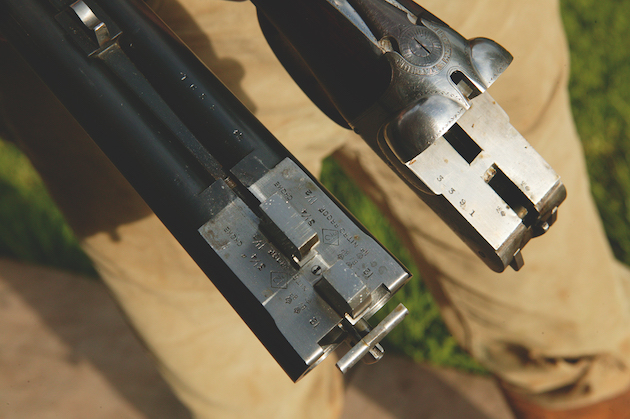
It is vital to check your gun can handle steel shot before you use it
To add to the confusion, steel shot is marginally different in its sizing. For clays, No 7 shot in steel is 2.54mm with 422 pellets per oz, No 7 shot in lead is 2.4mm with 340 pellets per oz. For game, No 4 shot in steel is 3.25mm with 192 pellets per oz, No 4 shot in lead is 3.1mm with 170 pellets per oz. Most non-toxic shot is governed by the steel shot size chart and is very precise in its sizing and must be within 0.05mm tolerance.
Get the latest news delivered direct to your door
Discover the ultimate companion for field sports enthusiasts with Shooting Times & Country Magazine, the UK’s leading weekly publication that has been at the forefront of shooting culture since 1882. Subscribers gain access to expert tips, comprehensive gear reviews, seasonal advice and a vibrant community of like-minded shooters.
Save on shop price when you subscribe with weekly issues featuring in-depth articles on gundog training, exclusive member offers and access to the digital back issue library. A Shooting Times & Country subscription is more than a magazine, don’t just read about the countryside; immerse yourself in its most authoritative and engaging publication.

